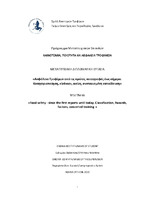| dc.contributor.advisor | Λαμπροπούλου, Κυριακή | |
| dc.contributor.author | Ευθυμίου, Σπυριδούλα Βαλεντίνη | |
| dc.date.accessioned | 2022-07-20T08:32:36Z | |
| dc.date.available | 2022-07-20T08:32:36Z | |
| dc.date.issued | 2022-05 | |
| dc.identifier.uri | https://polynoe.lib.uniwa.gr/xmlui/handle/11400/2562 | |
| dc.identifier.uri | http://dx.doi.org/10.26265/polynoe-2402 | |
| dc.description.abstract | Σκοπός της παρούσας εργασίας είναι η συγκέντρωση των σημαντικότερων καταγραφών που αφορούν στην ασφάλεια τροφίμων στις μέρες μας, η κατηγοριοποίησή τους και η πρόταση τρόπων μείωσής τους. Αρχικά παρουσιάζονται οι κατηγορίες των κινδύνων και ταξινομούνται σε μικροβιολογικούς, φυσικούς και χημικούς. Στη συνέχεια ακολουθεί βιβλιογραφική ανασκόπηση των σημαντικότερων περιστατικών μόλυνσης τροφίμων που συνέβησαν τον 19ο και τον 20ο αιώνα και πιο αναλυτικά οι καταγραφές του 21ου αιώνα. Ύστερα γίνεται κατηγοριοποίηση και στατιστική ανάλυση των καταγραφών, οι οποίες φαίνεται ότι αρχικά περιλαμβάνουν μικροβιολογικούς και χημικούς κινδύνους, ενώ στις πιο πρόσφατες καταγραφές παρατηρούνται και περιστατικά που οφείλονται σε φυσικούς κινδύνους. Επίσης, ανάλογα με την ήπειρο επικρατούν διαφορετικοί κίνδυνοι, ενώ τα περισσότερα καταγεγραμμένα περιστατικά εμφανίζονται στην Αμερική, την Ασία και την Ευρώπη. Ακολουθεί η ξεχωριστή ανάλυση των αιτιών που οδηγούν σε τέτοια περιστατικά, τα οποία εντοπίζονται σε σφάλματα της βιομηχανίας, των παραγωγών τροφίμων και του καταναλωτή. Τέλος, προτείνονται δράσεις συντονισμένης εκπαίδευσης σε όλα τα επίπεδα που συμβάλλουν στην εμφάνιση τροφικών δηλητηριάσεων, με την οργάνωση σεμιναρίων και δράσεων εκπαίδευσης στη βιομηχανία, προγραμμάτων εκπαίδευσης των παραγωγών και δράσεων ενημέρωσης των καταναλωτών για τους κινδύνους των τροφίμων και τη διαχείρισή τους. Σκοπός της συντονισμένης, πολυεπίπεδης εκπαίδευσης είναι η αλλαγή συνηθειών, συμπεριφορών και πρακτικών για πιο ασφαλή τρόφιμα. | el |
| dc.format.extent | 77 | el |
| dc.language.iso | el | el |
| dc.publisher | Πανεπιστήμιο Δυτικής Αττικής | el |
| dc.rights | Αναφορά Δημιουργού - Μη Εμπορική Χρήση - Παρόμοια Διανομή 4.0 Διεθνές | * |
| dc.rights | Attribution-NonCommercial-NoDerivatives 4.0 Διεθνές | * |
| dc.rights.uri | http://creativecommons.org/licenses/by-nc-nd/4.0/ | * |
| dc.subject | Τροφολοιμώξεις | el |
| dc.title | Ασφάλεια τροφίμων από τις πρώτες καταγραφές έως σήμερα. Κατηγοριοποίηση, κίνδυνοι, αιτίες, συντονισμένη εκπαίδευση | el |
| dc.title.alternative | Food safety - since the first reports until today. Classification, hazards, factors, concerted training | el |
| dc.type | Μεταπτυχιακή διπλωματική εργασία | el |
| dc.contributor.committee | Κοντελές, Σπυρίδων | |
| dc.contributor.committee | Tsaknis, John | |
| dc.contributor.faculty | Σχολή Επιστημών Τροφίμων | el |
| dc.contributor.department | Τμήμα Επιστήμης και Τεχνολογίας Τροφίμων | el |
| dc.contributor.master | Καινοτομία, Ποιότητα και Ασφάλεια Τροφίμων | el |
| dc.description.abstracttranslated | The aim of this MSc thesis is the collection of the most important cases connected to food safety recorded in the 21st century, the classification of these cases and the proposal of possible solutions that could eliminate their numbers. The food hazards are classified into biological, chemical and physical hazards. A literature review is being conducted, referring to the most important food safety cases recorded in the 19th and 20th century, followed by a more detailed review of the most important recorded cases of the 21st century globally. The cases of the 21st century get further classified and analyzed statistically, leading to the conclusion that the earlier cases refer to chemical and biological hazards, while in the latter ones, physical hazards are also observed. Furthermore, depending on the continent, different hazards prevail, while the biggest part of the cases are recorded in America, Asia and Europe. The analysis of what caused each one of these incidents shows industry, producers’ and customers’ faults. Finally, actions of concerted training are being proposed, aiming to be implemented on all the aspects that lead to unsafe food. The actions contain seminars and training actions in the industry, training programs for the producers and actions for consumer’s awareness about the food hazards and the handling of them. The aim of this concerted and multidimensional training is the change of the habits, behavior and practice, that will lead to safer food. | el |



